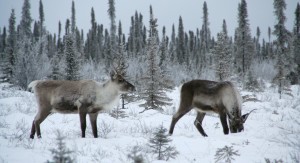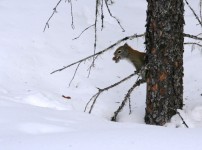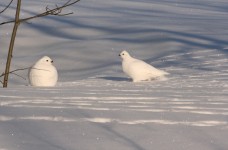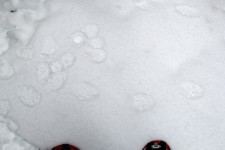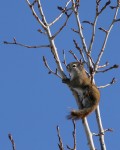When the snow becomes deep enough, we bring out our skis, snowshoes and snowmobiles to travel around. Even with snowshoes, slogging through knee-deep powdery snow can be exhausting if you are breaking trail. Worse is a thin icy crust that doesn’t support your weight and you punch through with each step.
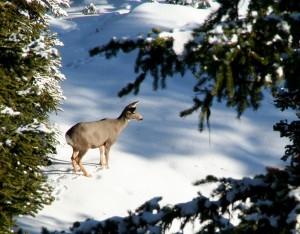
When snow becomes more than a foot deep, the movement of mule deer is hampered. When snow depth is greater than two feet, mule deer tend to leave the area to find shallower snow for easier foraging.
If an animal doesn’t hibernate or migrate, it has to move through the snowy landscape in the least exhausting way possible to save energy. Each animal has its own way of traveling through the snow.
Snow-loving animals, called chionophiles, have adaptations for winter and include snowshoe hares, caribou and ptarmigan.
Snowshoe hares have built-in snowshoes with their large hind feet and the ability to spread their toes. These “snowshoes” enable them to walk on top of the snow.
Woodland caribou spend the winter in deep-snow areas to avoid predators because their large hooves can spread wide in the snow and act like snowshoes.
Ptarmigan also create “snowshoes” for winter. They grow feathers on their feet which creates a larger surface area for them to walk on top of the snow.
Others with large feet include lynx and wolverines. The large feet of lynx allow them to hunt in deep snow without expending tremendous amounts of energy.
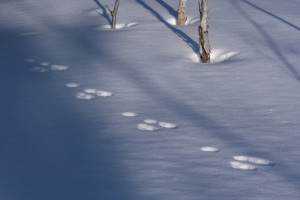
A snowshoe hare’s large feet enable it to stay on top of the snow. Their hind feet can spread as wide as 4.5 inches to increase surface area.
Wolverines have the largest feet for their size and the lowest weight-to-foot-size ratio of any predator in North America. If snow conditions are suitable, wolverines can travel farther than in the summer because of fewer obstructions. Even with large feet deep, soft snow hampers a wolverine’s ability to travel. Then wolverines shift their activity to areas under mature conifer cover where snow is less deep or to areas where the snow is compacted or reduced by the sun or wind.
Mountain goats move to southerly-facing slopes or cliffs where the wind blows the snow away or the sun melts the snow more quickly.
When the snow becomes deeper than six inches, a bobcat’s mobility is hampered and it moves to forest cover or cliffy areas that shed snow.
Moose tend to spend winter in closed-canopy coniferous forest stands where there is protection from accumulating snow. As little as 23 to 28 inches of snow begins to hinder their movement which is why we often see them on plowed roads or encounter their tracks on trails.
When the snow is deep, deer move to dense conifer stands because snow depth can be up to 50 percent less. Their small feet are no match for deep snow and travel through it can be exhausting. Deer “yard up” in conifer stands and create a network of trails to ease movement to feeding areas. Following trails reduces the energy expended to reach the low-nutrient food they feed on in winter.
Snowshoe hares and porcupines also create trails to and from feeding areas. The short legs of a porcupine causes it to plow a trough through the snow so the exhausting endeavor is restricted to the closest feeding trees.
Elk trails are commonly seen in any depth of snow. The long legs of elk allow them to plow through the snow but to reduce energy output the herd follows the lead animal who breaks a trail.
Animals even take advantage of human-made and natural trails. Coyotes and wolverines travel on snowshoe, ski or snowmobile trails to access other areas. Wolves travel on roads, ski trails, snowmobile trails, and frozen lakes and rivers to hunt. Bobcats and lynx walk on snowmobile trails, packed animal trails or logs when moving through soft snow.
Whether an animal has built-in snowshoes or follows snowshoe trails, travel in winter is about reducing the energy needed to reach food. Whether deep snow is advantageous or not depends on the animal, which I’ll write about next week.

